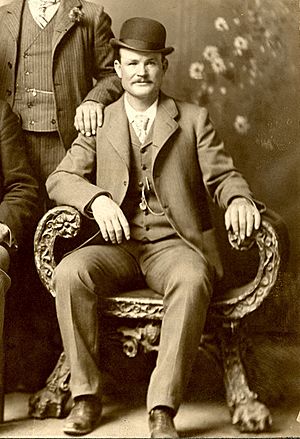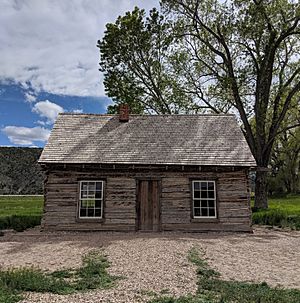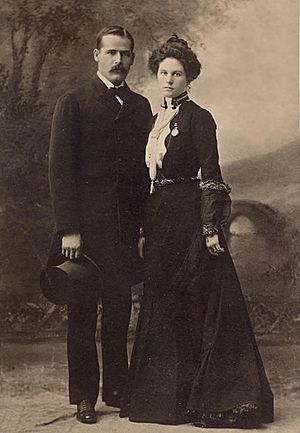Butch Cassidy facts for kids
Quick facts for kids
Butch Cassidy
|
|
|---|---|

Cassidy c. 1900
|
|
| Born |
Robert LeRoy Parker
April 13, 1866 Beaver, Utah Territory, U.S.
|
| Died | November 7, 1908 (aged 42) |
| Cause of death | Gunshot wounds |
| Other names | Butch Cassidy, Mike Cassidy, George Cassidy, Jim Lowe, Santiago Maxwell |
| Occupation | Farm hand, cowboy, butcher, thief, robber, gang leader, outlaw |
| Allegiance | Butch Cassidy's Wild Bunch |
| Conviction(s) | Imprisoned in the territorial prison in Laramie, Wyoming for horse theft |
| Criminal charge | Horse theft, cattle rustling, bank and train robbery |
| Penalty | Served 18 months of a two-year sentence; released January 1896 |
Robert LeRoy Parker (born April 13, 1866 – died November 7, 1908), better known as Butch Cassidy, was a famous American train and bank robber. He led a group of outlaws called the "Wild Bunch" in the Old West.
Butch Cassidy was involved in criminal activities for over ten years. He was constantly chased by law enforcement, especially the Pinkerton detective agency. This pressure made him leave the United States. He escaped with his friend Harry Longabaugh, also known as the "Sundance Kid", and Longabaugh's girlfriend Etta Place. They first went to Argentina and then to Bolivia. Most people believe Parker and Longabaugh were killed in a shootout with the Bolivian Army in November 1908. However, the exact details of their deaths are still debated today.
Butch Cassidy's life and death have been shown in many movies, TV shows, and books. He remains one of the most famous figures from the "Wild West" stories.
Contents
Early Life of Butch Cassidy
Robert LeRoy Parker was born on April 13, 1866, in Beaver, Utah Territory. He was the first of 13 children born to English immigrants Maximillian Parker and Ann Campbell Gillies. His parents had become Mormons while still living in the United Kingdom.
Robert grew up on his parents' ranch near Circleville. As a teenager, he left home. While working on a dairy ranch, he met a cattle thief named Mike Cassidy. Later, Robert worked on several ranches. He also spent a short time as a butcher in Rock Springs, Wyoming. This is where he got his famous nickname, "Butch," from the word "butcher." He soon added "Cassidy" to his name to honor his friend and mentor.
Escape to South America
Butch Cassidy and the Sundance Kid felt constant pressure from law enforcement. Their gang was also falling apart. So, they decided to flee to New York City. On February 20, 1901, they left for Buenos Aires, Argentina, on a British ship called the Herminius. Longabaugh's companion, Etta Place, joined them. Cassidy pretended to be James Ryan, Etta's made-up brother.
They settled on a 15,000-acre ranch in Cholila, near the Andes mountains. They bought a four-room log cabin there. A letter Butch wrote in 1902 described their "little family of 3" living in the house. They had many animals, including 300 cattle, 1500 sheep, and 28 horses.
Life on the Run in South America
On February 14, 1905, two English-speaking bandits robbed the Banco de Tarapacá y Argentino in Río Gallegos. This town was about 700 miles south of Cholila. Cassidy and Longabaugh sold their ranch on May 1, fearing they had been found. The Pinkerton Agency actually knew where they were. However, the harsh winter in Patagonia had stopped their agent from arresting them.
The local governor issued an arrest warrant. But Sheriff Edward Humphreys, who was friendly with Cassidy, warned them. The trio then fled north to San Carlos de Bariloche. From there, they took a steamer across Nahuel Huapí Lake into Chile. They returned to Argentina later that year.
On December 19, Cassidy, Longabaugh, Place, and another man robbed the Banco de la Nación Argentina in Villa Mercedes. They took 12,000 pesos. After the robbery, they escaped across the Andes mountains back to Chile.
By June 30, 1906, Etta Place decided she was tired of running. Longabaugh took her back to San Francisco. Cassidy found honest work under the name James "Santiago" Maxwell. He worked at the Concordia Tin Mine in Bolivia. Longabaugh joined him there after returning from San Francisco. Their main job was guarding the company's payroll. In late 1907, they traveled to Santa Cruz, Bolivia. They still hoped to settle down as respectable ranchers.
The Disputed Death
On November 3, 1908, a messenger was carrying the payroll for a silver mine near San Vicente. He was attacked by two masked American bandits. These bandits were believed to be Cassidy and Longabaugh. Three days later, witnesses saw them in San Vicente. They stayed in a small boarding house. The owner, Bonifacio Casasola, became suspicious. The bandits had a mule with the mine's brand on it.
Casasola told a nearby telegraph officer. The officer then informed a cavalry unit. Three soldiers, led by Captain Justo Concha, were sent. They also told the local police. On the evening of November 6, soldiers, the police chief, and the mayor surrounded the house. They planned to arrest the robbers.
As they approached, the bandits started shooting. A gunfight lasted for several hours into the night. Around 2:00 am, the mayor heard a man scream three times inside the house. Then, two shots were fired from inside.
The next morning, authorities entered the house. They found two bodies. The police identified them as the men who robbed the payroll. However, the Bolivian authorities did not know their real names. They could not positively identify them as Cassidy and Longabaugh.
The two men were buried in the small San Vicente cemetery. In 1991, scientists tried to find the graves. They did not find any remains that matched the DNA of Cassidy and Longabaugh's living relatives. A new search in 2017 also found human remains, but they did not match the DNA.
Rumors of Survival
Even though the Bolivian authorities believed Butch Cassidy died, many rumors say he survived. Some stories claim he returned to the United States.
One story says that a doctor saw Cassidy in the 1930s. Cassidy supposedly told him that a surgeon in Paris had changed his face. He also showed the doctor an old bullet wound that the doctor recognized.
In 1960, Josie Bassett claimed that Cassidy visited her in the 1920s after returning from South America. She said he died in Nevada around 15 years later. People in Cassidy's hometown of Circleville, Utah, also claimed he worked in Nevada until his death.
Butch Cassidy's great-niece, Bill Betenson, said he returned to Utah many times to visit his family. She believes he came back in 1925 and died in Washington in the late 1930s. She said the family agreed not to share his final resting place. This was so he could "rest in peace" after being chased his whole life.
In 2019, an investigation looked into claims that Cassidy was secretly buried at a cabin on his family's ranch in Circleville. A neighbor claimed to have seen the burial in 1937. Dogs were brought to the cabin and showed a positive sign. Later, two bones were found under the cabin. DNA tests confirmed they were human. However, there wasn't enough DNA for a full profile. It is believed the family later moved Cassidy's remains to a different spot.
Aliases
Butch Cassidy used several different names to hide his identity:
- George Parker
- George Cassidy
- Lowe Maxwell
- James "Santiago" Maxwell
- James Ryan
- Butch Cassidy
- Santiago Lowe
- Jim Lowe
See also
 In Spanish: Butch Cassidy para niños
In Spanish: Butch Cassidy para niños
- List of fugitives from justice who disappeared



